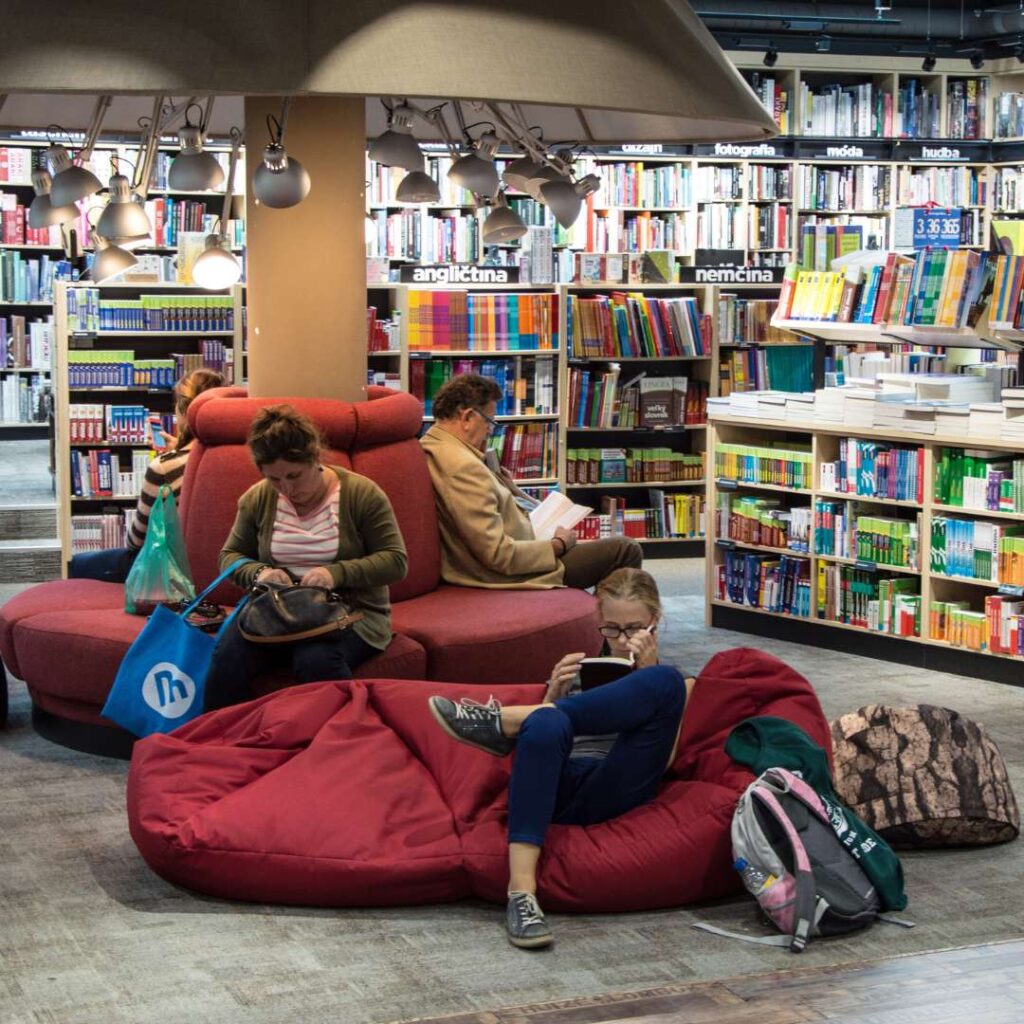Table of Contents
- Introduction
- 1. Waterstones Piccadilly (London, UK)
- 2. Lello Bookstore (Porto, Portugal)
- 3. FNAC Ternes (Paris, France)
- 4. Casa del Libro Gran Vía (Madrid, Spain)
- 5. Hoepli (Milan, Italy)
- 6. Dussmann das KulturKaufhaus (Berlin, Germany)
- 7. Thalia Buchhandlung (Hamburg, Germany)
- 8. Akateeminen Kirjakauppa (Helsinki, Finland)
- 9. Shakespeare and Company (Paris, France)
- 10. Carturesti Carusel (Bucharest, Romania)
- Conclusion
Introduction
Europe has always been a literary powerhouse. With its deep intellectual traditions, centuries-old publishing houses, and cities that have inspired everything from Gothic novels to modernist masterpieces, the continent is a natural home for bookstores of extraordinary size and significance. In 2025, even as digital publishing continues its steady march forward, the brick-and-mortar bookstore has not only endured—it has evolved, expanded, and in many cases, flourished. From historic icons nestled in capital cities to sprawling, modernized hubs redefining the retail experience, Europe’s largest bookstores represent far more than just places to buy books. They are cultural landmarks, tourist attractions, and centers of literary life.
This article explores the ten largest bookstores in Europe in 2025. Each of these giants impresses not just by size—be it square footage, number of titles, or sheer visitor volume—but by ambition and adaptability. These are the kinds of places that merge tradition with innovation, offering everything from rare tomes and academic publications to coffee bars, live events, and multimedia lounges. We journey across the continent, from the book-lined arcades of London to the buzzing cultural plazas of Eastern Europe, to bring you an up-to-date list of Europe’s largest and most iconic book havens.
If you’re someone who finds joy in wandering endless aisles of books, or if you’re curious about how physical bookstores are reinventing themselves in the digital age, this tour of Europe’s largest book retailers is your passport to inspiration.
1. Waterstones Piccadilly (London, UK)
Waterstones Piccadilly has long held the crown as the largest bookstore in Europe, and in 2025, it’s still at the top of the list. With over 55,000 square feet of space spread across eight floors, this literary institution is more than just a bookstore—it’s a book lover’s paradise. The location is iconic, nestled in the heart of central London, just a stone’s throw from Piccadilly Circus. It occupies the former Simpson’s department store, and its elegant Art Deco architecture gives it a timeless charm.
What makes Waterstones Piccadilly truly special isn’t just its size. It’s the atmosphere. From curated reading rooms to the fifth-floor bar offering panoramic views of the city, the store is designed to make visitors linger. The events calendar is packed with author talks, literary salons, and themed nights. The selection is enormous, covering everything from fiction to politics, science to poetry, and even an entire floor dedicated to children’s books. In 2025, they’ve also integrated augmented reality guides and personalized recommendation kiosks, helping readers discover hidden gems amid the shelves.
2. Lello Bookstore (Porto, Portugal)
Though not the largest in floor area, Livraria Lello in Porto earns its place on this list because of its towering bookcases, architectural majesty, and growing footprint in 2025. This neo-Gothic bookstore, often cited among the most beautiful bookstores in the world, underwent a massive expansion project completed in late 2024, doubling its visitor capacity and extending its rare book and collectible sections.
Lello’s connection to the Harry Potter fandom continues to drive traffic, but in recent years, it has cleverly shifted the narrative. By investing in Portuguese literary heritage, it now offers extensive multilingual collections, academic titles, and even a boutique publishing arm. In 2025, it functions not just as a store but as a cultural ambassador, hosting weekly readings and publishing new editions of Portuguese classics. The stunning stained glass ceiling and winding staircase remain highlights, but the soul of the bookstore lies in its ability to inspire curiosity about books and history alike.
3. FNAC Ternes (Paris, France)
France has long taken its literary culture seriously, and FNAC Ternes in Paris is a case in point. Situated in the 17th arrondissement, this flagship location is the largest in the FNAC chain, stretching over 40,000 square feet. It combines books, music, film, and electronics under one roof, creating an integrated cultural hub that caters to nearly every type of media consumer.
In 2025, FNAC Ternes stands out not just for its breadth but for its reinvention. While many European chains have struggled to maintain physical locations, FNAC has doubled down on its hybrid model. Walk through the doors today and you’ll find immersive zones for audiobooks, digital textbooks, and even VR reading experiences. Yet the heart of the store remains its literary collection, particularly strong in French and Francophone literature, art books, philosophy, and children’s literature. It also hosts a busy calendar of events, often tied to current affairs, film releases, and major literary festivals.
4. Casa del Libro Gran Vía (Madrid, Spain)
Casa del Libro is the most prominent bookstore chain in Spain, and its flagship store on Madrid’s Gran Vía is a behemoth in its own right. In 2025, the store spans nearly 37,000 square feet and remains a centerpiece of the city’s literary life. Open since 1923, it has constantly evolved, integrating cutting-edge retail strategies while maintaining a deep respect for literary tradition.
Visitors today will find multi-floor book halls organized with elegant clarity. Spanish literature dominates, but there are extensive foreign language sections, along with robust offerings in travel, gastronomy, and academic publishing. A standout feature in 2025 is its new print-on-demand service, allowing readers to request rare or out-of-print books and receive them within minutes. The addition of a co-working space and a literary café has also turned the store into a daytime retreat for students, professionals, and tourists alike.
5. Hoepli (Milan, Italy)
Hoepli has served Milan’s reading public since 1870, and in 2025, it continues to thrive as one of Europe’s largest independent bookstores. With over 500,000 books in stock and several interconnected buildings forming a literary maze, Hoepli spans approximately 35,000 square feet in the center of Milan. The store is known for its depth in technical subjects—engineering, architecture, science—and its robust selection of language-learning materials.
In an era where attention spans are under siege, Hoepli offers quiet, deeply focused reading zones, which have become unexpectedly popular among younger patrons. Its international reach has also expanded; partnerships with academic presses and global publishers ensure a steady stream of English and German-language titles. The bookstore’s event calendar is as diverse as its shelves, offering everything from AI seminars to historical fiction discussions. In short, Hoepli is the rare kind of bookstore that feels both rooted in tradition and responsive to the future.
6. Dussmann das KulturKaufhaus (Berlin, Germany)
Berlin’s Dussmann KulturKaufhaus is a five-story mega-bookstore that blurs the line between cultural department store and literary sanctuary. Located on Friedrichstraße, it offers 7,000 square meters (about 75,000 square feet) of books, music, and multimedia content. Its 24-hour reading lounge and late-night opening hours make it a go-to destination for students, night owls, and tourists alike.
In 2025, Dussmann continues to embrace Berlin’s creative spirit by offering spaces for local authors, zine makers, and indie publishers. A major renovation completed in 2023 added an entire floor dedicated to international literature and a permanent exhibit space for rotating cultural themes. It’s one of the few places where you can pick up a book, catch a chamber music recital, and attend a manga drawing workshop all in one evening. Its success lies in its diversity—not just of content, but of experience.
7. Thalia Buchhandlung (Hamburg, Germany)
Thalia is Germany’s largest bookstore chain, but its Hamburg flagship on Spitalerstraße is in a league of its own. This expansive store covers more than 28,000 square feet and integrates modern retailing technology with classic German book culture. Known for its warm interiors and well-organized sections, the Hamburg Thalia attracts a mix of local readers, tourists, and curious shoppers.
In 2025, Thalia has leaned hard into personalization. AI-driven discovery tables and voice-assisted browsing make finding new titles both intuitive and fun. At the same time, its commitment to in-store human expertise—real booksellers with real opinions—remains central to the brand. The children’s floor is especially impressive, featuring interactive storytelling sessions and a new range of “reading pods” designed for immersive solo reading.
8. Akateeminen Kirjakauppa (Helsinki, Finland)
The Academic Bookstore (Akateeminen Kirjakauppa) in Helsinki is a Nordic marvel. Designed by the legendary Alvar Aalto, it’s more than just a bookstore—it’s an architectural icon. While the store experienced financial uncertainty a few years ago, its revival under a new ownership group has brought renewed energy, expanded inventory, and enhanced community engagement.

In 2025, Akateeminen has solidified its status as a key player in the Nordic book market. It’s particularly strong in academic and nonfiction offerings, with impressive Scandinavian literature and design collections. The airy, minimalist layout offers a different kind of grandeur—serene, uncluttered, and bathed in natural light. It’s not the largest by square footage, but few bookstores offer this kind of aesthetic and intellectual space in one.
9. Shakespeare and Company (Paris, France)
Famous for its bohemian history and ties to the expat literary scene, Shakespeare and Company may not be the largest in square meters, but in terms of cultural weight, it punches far above its size. That said, its expansion in 2024 added a second adjoining unit, increasing its floor area and stock capacity significantly, now making it one of the larger independent bookstores in Western Europe.
In 2025, the store still operates with its idiosyncratic charm—walls of books, hidden staircases, and an upstairs reading room where visitors can still sleep in exchange for a few hours of work and reading. It’s a living relic of literary history that has modernized gently: you’ll now find a robust online store, podcast studio, and live streaming events alongside the usual poetry readings and author talks. It’s proof that even the most romantic, old-world bookstores can adapt and grow without losing their soul.
10. Carturesti Carusel (Bucharest, Romania)
Carturesti Carusel is perhaps the most visually striking bookstore on this list. Located in a restored 19th-century bank building in the heart of Bucharest’s old town, the bookstore opened in 2015 and has continued to grow in stature and influence. With 1,000 square meters (10,700 square feet) spread over six floors, it’s not the largest in raw size, but it’s one of the most talked about—and Instagrammed—bookstores in Europe.
In 2025, Carturesti Carusel has become a symbol of Romanian cultural revival. It hosts local publishers, literary festivals, and even political debates. The top-floor café is buzzing day and night, and the basement gallery space regularly features contemporary art exhibitions. The store’s interior is a masterclass in design: light, open, and welcoming, with white columns and spiral staircases guiding visitors from floor to floor. It’s a modern cultural salon in the truest sense.
Conclusion
The landscape of bookselling in Europe in 2025 is nothing short of dynamic. As these ten bookstores show, size is more than a numbers game. It’s about cultural impact, adaptability, and the ability to create meaningful spaces for exploration, learning, and community. These bookstores aren’t just surviving in a digital age—they’re thriving by becoming destinations in their own right.
Whether it’s a tech-integrated superstore in Berlin, a historic literary landmark in Paris, or a reinvented architectural gem in Helsinki, each of these European book giants offers a unique story. They invite us not just to buy books, but to experience them—to get lost in thought, discover new perspectives, and, above all, fall in love with reading all over again. Here’s to the enduring magic of bookstores, one square meter at a time.

1 thought on “10 Largest Bookstores in Europe in 2025”